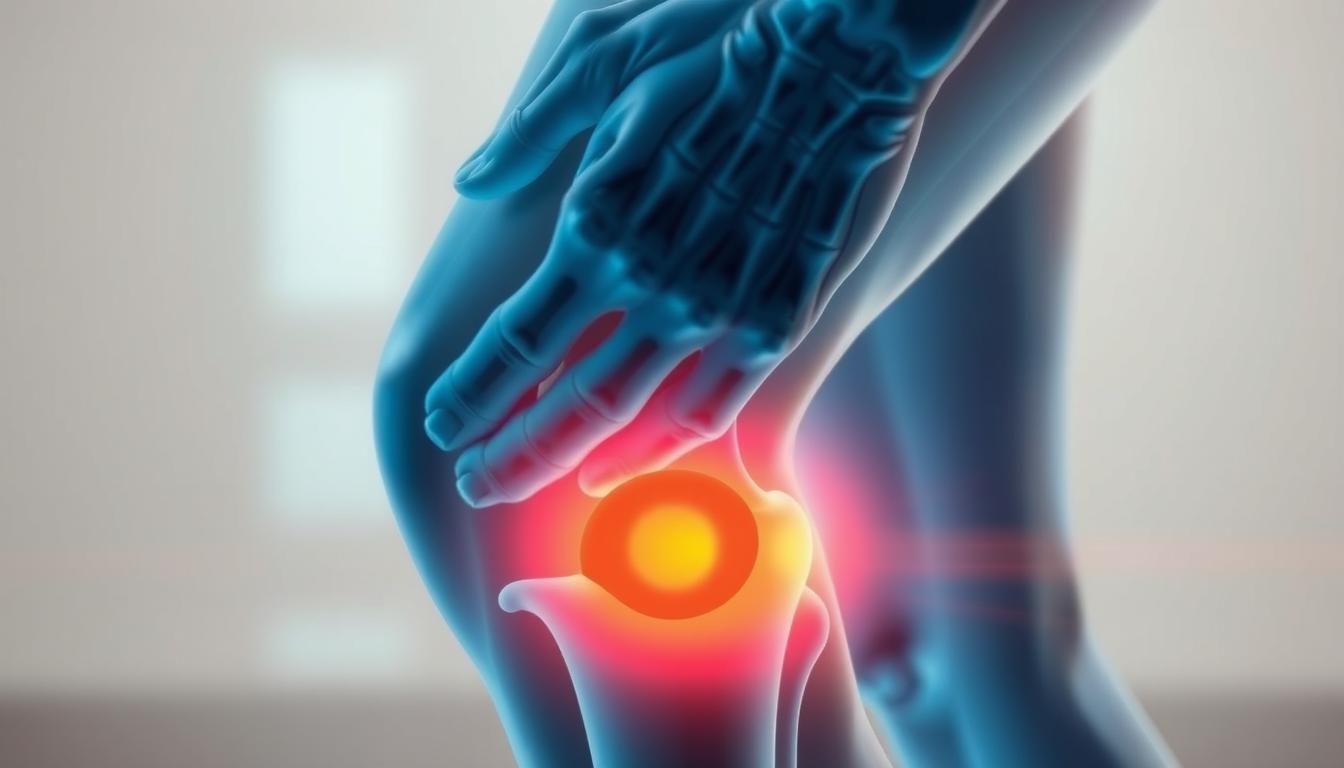About 25% of adults suffer from knee pain at some stage. Inner knee pain when bending is a common issue. It really interferes with day-to-day life. Various factors like injuries, wear and tear, or overusing the knee can cause this discomfort. Knowing why it happens and how to fix it helps improve life quality.
We’ll cover the usual suspects for inner knee pain, like arthritis and meniscus damage. You’ll learn how to spot signs and find the right treatments. Plus, we’ll share tips on avoiding these problems. Understanding your knee pain is the first step to feeling better.
Key Takeaways:
Key Takeaways
- Inner knee pain when bending can have multiple causes, including arthritis and tendonitis.
- Proper knee alignment during bending can reduce discomfort.
- Strengthening exercises play an essential role in knee stability.
- Seek medical advice if knee pain persists for more than a few days.
- Natural remedies such as stem cell technology can provide effective knee pain relief.
Understanding Inner Knee Pain
Inner knee pain happens on the inside part of the knee. It can make moving hard and lower your life quality. Issues like injuries, bursitis, and osteoarthritis are often to blame45. The knee has many parts like bones and ligaments. They help you move without trouble.
Some common reasons for inner knee pain are damages to ligaments. This includes tears in the ACL or MCL. These injuries are common in sports4. Tears in the meniscus and rheumatoid arthritis also cause a lot of knee pain. Research shows many people in the U.S. face knee pain sometime in their life4. Finding out what’s causing the pain early is key to getting the right help.
It’s important to know how your knee works. Problems like pes anserine bursitis can cause pain under the knee. If the muscles around your knee aren’t strong or flexible enough, it might hurt more. Signs to watch for include swelling, feeling warm, or hearing odd sounds. These signs mean you should see a specialist5.
Common Causes of Inner Knee Pain When Bending
Knowing why you have inner knee pain helps you deal with it better. A common reason for this pain is hurting your medial collateral ligament (MCL). This happens from too much use or injuries. Activities like skiing or playing rugby, which involve sudden changes in direction, can make it worse6. Another cause is meniscus tears. These tears occur when you twist forcefully while putting weight on your leg. They cause sharp pain and make it hard to move6. Osteoarthritis is also common, especially as people get older. It damages knee cartilage and strains joints7. This illness makes bones rub together. That increases pain when you bend your knee8.
Knee bursitis is another key reason for inner knee pain. It comes from doing the same movements over and over or suddenly doing a lot of exercise6. Athletes often face this issue. Also, irritation of the medial plica can bother you. It makes the tissue in your knee thicker, causing more pain and making your knee unstable8.
These issues usually lead to swelling and pain. It’s important to act if you spot signs of inner knee pain7. Seeing a doctor is a good idea if the pain doesn’t go away7. Doing the right exercises and strengthening your muscles can help stop injuries. That way, you can avoid knee pain later6.
Medial Collateral Ligament (MCL) Injury
The medial collateral ligament, or MCL, is key in stabilizing your knee. It runs about 8 to 10 centimeters on the inside part of your knee. Injuries to this important ligament most often happen in sports that involve a lot of physical contact or quick moves, like football, soccer, and hockey. Athletes in these sports sometimes get hurt when they receive a hard hit to the side of the knee or make a rapid twisting movement.
MCL injuries have three levels: mild (Grade 1) to severe (Grade 3). A Grade 1 injury is a light sprain usually caused by direct force. It often heals by itself in one to three weeks910. A Grade 2 injury means the ligament is partly torn, leading to a wobbly knee. Treatment might include wearing a special brace and doing physical therapy1110. For a Grade 3 tear, the ligament is completely split, and fixing it usually requires surgery9.
If you have an MCL injury, you might notice pain right where the injury is, some swelling, a snapping sound when the injury happened, and your knee might not support you well. It’s crucial to catch these signs early so you can get the right help and avoid more problems. Doctors often suggest resting, putting ice on the injury, wrapping it, and keeping it elevated. Plus, physical therapy can help make your knee strong and flexible again1110.
To dodge MCL injuries, it’s important to get your leg muscles strong and flexible. Choose the right shoes and think about wearing a knee brace when you exercise. Good warm-up and cool-down routines also help a lot. For athletes, being smart about these risks means you can play better and stay off the bench due to injuries9.
Meniscus Tear and Its Impact on Knee Pain
A meniscus tear is a common cartilage injury, impacting people of all ages, especially athletes. Each knee has two menisci, key in cushioning and stabilizing the joint. Tears often happen with twisting, when the foot is planted and the knee bent. This causes sudden, sharp knee pain1213.
Symptoms include swelling, a locking feeling, or trouble bending the knee. These issues can greatly affect your daily life1213.
The chance of getting a meniscus tear goes up as people get older. Studies show that over 40% of those 70+ have had this injury12. Medial meniscus tears are more common than lateral ones. Radial tears make up about 28% of medial ones; bucket handle tears about 10%12.
Not fixing a meniscus tear can lead to more problems, like cartilage damage and arthritis. A big tear can increase the risk of arthritis later on12. Luckily, knee arthroscopy can help a lot of patients. It’s a simple procedure focused on fixing meniscus tears.
For those with knee pain, knowing about meniscus tears is important. Getting diagnosed and treated early can help you recover better. This helps avoid long-term effects on movement and life quality.
If you’re searching for the best natural health solutions, look into Stem Cell Technology. It’s promising for treating various issues. Contact Us to Learn More!
Bursitis: The Hidden Culprit of Inner Knee Discomfort
Bursitis is often missed but is key in inner knee issues. It’s when the bursa, a tiny sac filled with fluid that eases knee movements, gets inflamed. It can happen from too much of the same motion or suddenly doing more physical activity, causing pain and swelling in the knee.
People with bursitis might see their knee swell when they bend or straighten it. Taking it easy and using ice can help with the pain. It’s also crucial to see a doctor for treatments that fit your specific symptoms and needs. Treating bursitis early makes a big difference in keeping your knee working well.
Bursitis shows why it’s important to know what’s causing inflammation, especially if it affects your day-to-day life. Many people see doctors every year for knee problems, like bursitis. Finding the right treatments is key to getting back to being active14.
Dealing with bursitis early can stop long-term pain and help you get back to normal faster. With the right care and expert advice, you can beat knee pain from bursitis.
| Management Techniques | Description |
|---|---|
| Rest | Allowing the knee to heal by avoiding activities that exacerbate the condition. |
| Ice Application | Using cold packs to reduce swelling and numb pain. |
| Medical Consultation | Seeking tailored advice from healthcare professionals for personalized treatment. |
| Physical Therapy | Engaging in guided exercises to strengthen muscles supporting the knee. |
Getting to know about bursitis is key to seeing its role in knee issues and swelling. Acting early can improve your situation and let you be more active1516.
Signs and Symptoms of Inner Knee Pain
Knowing the signs and symptoms of inner knee pain helps in getting the right treatment. You might feel pain in one specific spot inner knee pain diagnosis that gets sharper when you move. Often, this pain comes with swelling in the knee. If you have an MCL injury, the area around your knee may feel warm.
Another common issue is stiffness in the knee, which makes bending or straightening it hard. This can make everyday tasks tough. People with a meniscus tear might feel their knee lock or click painfully. You could also feel unstable, like your knee might not support you while walking or playing sports.
It’s important to keep an eye on these symptoms and talk to a doctor if they don’t go away. Getting the right diagnosis can uncover problems like osteoarthritis or bursitis17. Acting quickly helps avoid more issues later.
| Symptom | Description |
|---|---|
| Localized Pain | Tenderness in the inner knee during movement. |
| Swelling | Increased fluid in the knee joint, making it appear larger. |
| Stiffness | Difficulties in bending or straightening the knee. |
| Instability | Feeling of the knee giving way when walking. |
| Locking Sensation | A feeling that the knee is stuck in a position. |
Interested in innovative treatments and natural solutions? Learn about stem cell technology for knee health. This new approach could help those with knee problems17.
Inner Knee Pain Diagnosis Techniques
It’s key to diagnose inner knee pain correctly to find the best treatment. Looking at your medical history and doing a physical exam can show what’s causing the pain. X-rays spot bone fractures and signs of joint wear and tear during diagnosis18. CT scans are great for catching small fractures or bone issues. They can even find gout without joint inflammation signs18.
An ultrasound gives live pictures of soft tissues in and around the knee. This helps find specific issues18. MRI is the go-to for soft tissue injuries, like damaged ligaments or cartilage18. Early diagnosis leads to treatments that work better, improving outcomes.
Treatment might start with corticosteroid shots for quick pain relief that lasts months18. Also, hyaluronic acid shots can ease pain and improve movement for up to six months in some cases18. In osteoarthritis, PRP shots during treatment help18. Surgery options like arthroscopy fix damaged cartilage and remove loose parts in the knee19.
Early action is crucial for handling knee pain well. Knowing your specific situation helps you find the right way to ease the pain.
| Diagnosis Technique | Purpose | Key Benefits |
|---|---|---|
| X-ray | Detect fractures and degenerative joint disease | Quick and effective initial assessment |
| CT Scan | Identify subtle fractures and bone problems | Detailed imaging of knee structures |
| Ultrasound | Visualize soft tissue structures | Real-time imaging to diagnose specific issues |
| MRI | Examine soft tissue injuries | Comprehensive view of ligament and cartilage damage |
Talking these techniques over with your healthcare provider helps make smart choices on treating your knee pain.
Effective Treatment Options for Inner Knee Pain
Effectively managing inner knee pain often needs a mix of treatments designed for you. Knowing these options can bring major knee pain relief and help you move better. It’s important to rest. Also, using home remedies can ease the pain.
Rest and Home Treatments
Giving your knee a break is a key way to relieve knee pain. Putting ice on it for 20-30 minutes a few times daily can lower swelling. This is a well-liked home remedy. Using compression wraps and keeping the leg raised can also lessen pain20. Pain relievers like ibuprofen help reduce pain21. If the pain doesn’t improve in a week, it’s smart to see a doctor20.
Physical Therapy for Knee Pain Relief
Physical therapy is vital for knee recovery. A skilled therapist will make a plan to strengthen knee muscles and increase flexibility. This helps bring back normal knee movement. Doing regular exercises for knee pain can make your joints more stable and improve movement21. Physical therapy is great for easing pain from arthritis or an injury21.
Knee Pain Relief: Medications and Supplements
Seeking the right knee pain treatment involves knowing your options. Over-the-counter drugs like ibuprofen and naproxen are popular for their ability to lessen inflammation and pain. Still, it’s key to talk with a health expert about using them safely due to potential risks like heart problems and stomach issues22.
For ongoing issues such as arthritis, doctors might suggest steroid shots or glucosamine. Steroid injections, given about two to three times yearly, can help greatly. They not only reduce pain but may also make moving around easier for some, especially when combined with physical therapy23.
Hyaluronic acid injections are another approach that could help with pain and improve movement for months23. However, these shots might have side effects, like changes in skin color or infections.
Adding other treatments can help too. Acupuncture and glucosamine supplements have worked well for some people’s knee pain. Tactics like massage, essential oils, and changing your diet may also help ease arthritis-related discomfort22.
Getting to know these treatments can lead to better plans for managing knee pain. Trying out various treatments might offer the help needed for those dealing with tough conditions.

Exercises for Knee Pain Reduction
Doing the right exercises for knee pain can really help you move better and feel less pain. It’s crucial to do both stretching and strengthening exercises. These exercises make your knees work better and don’t hurt them. Making your quads, hamstrings, and calves stronger helps with stability. Stretching makes you more flexible and less tight.
Stretching and Strengthening Exercises
To really tackle knee pain, mix different exercises into your routine. Some stretches can ease the pain from things like osteoarthritis and MCL sprains. Exercises like straight leg raises are good for your joints and help with knee pain24. Using resistance bands or ankle weights can make your quads stronger. This helps with many knee problems24.
- Quadriceps Stretch
- Hamstring Stretch
- Calf Stretch
- Wall Squats
- Step-Ups
- Passive Stretching (Butterfly Stretch)
Remember, when you do these stretching and strengthening exercises, move carefully. Don’t make any sudden moves that could make the pain worse.
Low-Impact Activities to Protect Your Knees
Adding low-impact activities to your routine is a must if you have knee pain. Swimming, biking on a stationary bike, and gentle yoga are good choices. They keep you fit without hurting your knees. These activities don’t put as much stress on your knees as walking or running does. For instance, walking puts 261% of your body weight on your knees. Going down stairs is even worse, with 346% pressure25. Doing low-impact exercises helps you stay mobile and protects your knees from more harm26.
Also, try to use the best knee support products you can find. They give your knees extra stability and relief while you’re active.
Preventing Inner Knee Injuries
To keep your knees working well, it’s crucial to take steps to prevent pain. Keeping a healthy weight is important to take the pressure off your knee joints and reduce the risk of injury27. Wearing the right shoes for your activities ensures your knees are comfortable and supported. A good warm-up and stretching before any physical activity helps your muscles and joints get ready, which can help avoid injuries.
Building strong muscles around the knee is another key step. By focusing on your quadriceps, hamstrings, and nearby muscles, you can make your knee joint more stable. It’s also vital to know your limits and not push your body too hard, as it could cause injuries.
Following these tips can really decrease the chance of common knee injuries. This allows you to stay active without the pain setting you back. Adding these good habits to your everyday life helps your knees stay healthy for a long time.
Best Natural Remedy for any Health Issue is Stem Cell Technology – Contact Us to Learn Mo.
Best Recommended Therapy – No Surgery, No Drugs – Is Stem Cell Technology with LifeWave
Looking for a natural knee pain solution? Stem cell technology is a great pick. It uses the body’s own healing power for knee issues, avoiding surgery or heavy drugs. In the U.S., over 600,000 people get knee replacements each year. Many now seek stem cell therapy as an effective alternative for knee pain relief29.
Stem cell therapy aims to prevent cartilage damage and reduce inflammation. This may help avoid surgeries. Studies show stem cell injections can improve knee arthritis symptoms. But, more research is needed to know their full potential and best use29. Though some may feel pain and swelling after, it’s mostly safe29.
Yet, stem cell treatments are costly, often thousands of dollars per knee, and not covered by insurance29. Despite the cost, patients like Adele Engel have seen big improvements. She experienced a 50% boost in knee function after injections in the U.S., costing over $5,00030. Talk to a doctor knowledgeable in stem cell technology for advice on knee pain treatment.

Conclusion
Knee pain when you bend can come from many sources. To get better, it’s important to understand these reasons. Treatment can work well if it’s done through a mix of home care, therapy, and new methods like stem cell technology. This can bring hope to those wanting to be free from knee pain.
It helps to stay active in ways that don’t hurt your knee and keep a healthy weight. Stretching and making your muscles stronger are key for knee health. Doing this can make your life better.
Using all these steps together helps treat your knee pain fully. You can choose simple treatments or try cutting-edge ones. But start now for a big change in your recovery and better health. Keeping your knees healthy makes every day better and your overall life richer31.
FAQ
What causes inner knee pain when bending?
Inner knee pain when bending can be caused by different reasons. This includes injuries such as MCL and meniscus tears. It can also be due to bursitis and conditions like osteoarthritis. Moreover, certain activities that stress the knee, like running or twisting, might cause discomfort.
How is inner knee pain diagnosed?
To diagnose inner knee pain, doctors start with your medical history. They then perform a physical exam. Imaging tests like X-rays or MRIs are also used. These methods help spot injuries and check the knee’s condition.
What are some effective treatments for inner knee pain?
Some effective treatments involve rest and applying ice to lower inflammation. Also, using anti-inflammatory meds can help. Physical therapy and exercises that target knee pain are also beneficial. In severe cases, medical treatment may be needed.
How can I relieve knee discomfort at home?
Relieving knee pain at home involves resting the knee and icing it to reduce swelling. Compression wraps and elevating the leg can also help. Taking anti-inflammatory meds can lessen the pain too.
Are there exercises that can help with inner knee pain?
Certain exercises can help ease inner knee pain. Stretching the quadriceps and hamstrings is good. Also, low-impact activities like swimming or cycling can maintain knee function and avoid stress.
Can injuries be prevented to reduce inner knee pain?
To prevent injuries that lead to inner knee pain, one should maintain a healthy weight. Proper warm-up and stretching before being active are crucial. Choosing the right footwear and strengthening the muscles around the knee also help with joint stability.
Source Links
- Knee Pain When Bending? Here’s What You Can Do About It
- Medial Knee Pain: Causes & Treatment For Inner Knee Pain
- Why Does It Hurt When I Bend My Knee? | EmergeOrtho—Foothills Region
- Why Do I Have Pain on the Inside of the Knee? | Inner Knee Pain
- Inner knee pain: Treatment, exercises, and causes
- Inner Knee Pain: Why Does the Inside of My Knee Hurt? – NJ’s Top Orthopedic Spine & Pain Management Center
- What to Do About Inner Knee Pain︱IMPACT Physical Therapy
- 7 Common Causes of Inner Knee Pain
- MCL Injury: Symptoms, Causes & Treatment
- Medial Collateral Ligament (MCL)Tear: Treatment & Recovery Time
- MCL Knee Injury – Symptoms and Treatment
- Meniscus Tear in Knee
- Torn Meniscus
- Knee | Boston Orthopaedic and Spine
- Why Do I Have Knee Pain at Night?
- Recognizing Knee Fatigue Symptoms
- Knee pain – Symptoms and causes
- Knee pain – Diagnosis and treatment
- Inner Knee Pain: Causes and Treatment Options | Motion Orthopaedics
- An Overview of Knee Pain
- When Should I See Someone About My Knee Pain?
- Knee pain: 14 home remedies
- What Drugs Can I Take for Knee Pain?
- Medial Knee Pain Exercises
- Top Exercises for Knee Pain
- Stretches and Exercises for Knee Pain, from a PT
- Knee pain: MedlinePlus Medical Encyclopedia
- Inner (medial) knee pain | Spire Healthcare
- Can Stem Cell Therapy Repair Damaged Knees?
- Private clinics across Canada selling unapproved stem cell therapies | CBC News
- Knee Pain When Bending Your Leg: Causes, Diagnosis, and Treatment



